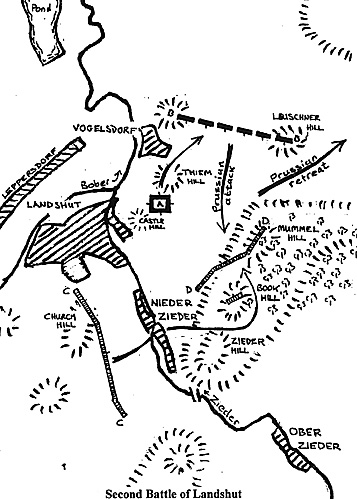The second action occurred during the Seven Years War after the Prussian invasion of Bohemia had ended in disaster at Kolin in June 1757 and involved forces of approximately similar size to those engaged in 1745. Again a force of Prussian regulars faced a larger detachment of Austrian light troops, but this time the Austrians were already in possession of the town and the fighting took place on the hills to the north. The quality of the Prussians also did not match those who had resisted so stoutly twelve years before and they did not have the support of a sizeable force of cavalry.
These inequalities were indicative of the fairly desperate state the Prussians faced in the summer of 1757. The defeats in Bohemia had opened the way to Austrian advances towards Silesia and Saxony. As in 1745, a small Prussian corps had been left to protect the mountain passes by Landshut and to cover the vital fortress of Schweidnitz, but losses elsewhere meant that this force was weaker than that which had guarded the area in 1745. Fearing for the safety Schweidnitz, the corps commander, Major General von Kreytzen, withdrew the men detached at Landshut opening the way to the Austrian light troops which had been reinforced after Kolin and instructed to raid into Silesia.
These numbered up to 4,000 men under the enterprising Major General Franz Jahnus who arrived to take command in July from Simbschen, veteran of the 1745 fight and now a full colonel in charge of a Slavonian Grenzer infantry regiment. Together they seized the empty town on 10 July and made several destructive forays into northern Silesia.
Kreytzen had some success against these, forcing Jahnus to retire to Landshut by early August. The minister in charge of the Prussian civil government of Silesia, von Schlabrendorff, thought it now opportune to attack Jahnus in order to recover the valuable revenue from the Landshut area. Kreyzten accordingly pulled out troops from nearby garrisons to assemble a field force totalling 3,000 and set off, arriving at Hartmannsdorf on the evening of 12 August. He was reluctant to proceed further as he had little idea of Jahnus' positions which were screened by the woods north of Landshut, but urged on by the bolder spirits in his staff, he set out the next afternoon.
In retrospect it is easy to criticize this as a mistake. The woods were found to be full of Grenzer infantry, forcing the Prussians to move closer to the Bober river towards Vogelsdorf. Despite having only 70 hussars, Kreytzen managed to discover that the enemy's main force was stationed south of the Zieder stream with its left on Church Hill. The commanding Buch Berg (Book Hill) north of the stream was still unoccupied and Kreytzen decided to seize it despite the fact that it was already 7pm. His corps advanced in two lines but were unable to reach it before darkness fell and were forced to halt in difficult, wooded terrain immediately south of Vogelsdorf. Proximity to the enemy prevented any rest and the Prussians remained under arms in a large square with their baggage in the center.
As soon as dusk fell, Jahnus sent 50 volunteers from the Peterwardein Grenzer to snipe at the Prussians and keep them in a constant state of alarm. Thirty horses were captured by the Grenzer and a hundred impressed Saxons serving in Grenadier Battalion Diezelsky took the opportunity to desert. Covered by the night, Jahnus moved men and guns into position on Book Hill and Castle Hill north of the Zieder stream, placing batteries on both hills, covered by a battalion of Peterwardeiner on Castle Hill and another of Warasdiner in the wooded edge of Book Hill. The rest of Jahnus' men took station on this hill with the battery of 6 guns on their right covered by two grenadier companies.
Kreytzen decided to fall back to the heights east of Vogelsdorf (Leuschner Hill) at dawn, but was spotted by Jahnus who opened fire from Book and Castle hills causing the Prussians to abandon most of their baggage and retreat at the double out of range. Once on Leuschner Hill they formed a single line and advanced back towards Book Hill. Grenadier battalions Kreytzen and Diezelsky evicted the Warasdiner from the trees and opened up on the Austrian battery with their battalion pieces. Without orders, the other four Prussian battalions followed the grenadiers and all six units climbed in a line towards the summit. Despite heavy fire they broke over the abatis prepared at the top, pushing back the Grenzer there and capturing the six cannon.
By now the attack had lost its impetus and the Prussians recoiled in the face of a counter attack against their front and flanks. As they tumbled down the slope, six of their own guns got stuck in the wet meadows at the foot of the hill and had to be abandoned. Only the remnants of the Diezelsky grenadiers retained any order and provided a rear guard as the force fled back to Schweidnitz.
In all 30 officers and 1,337 men were captured including the whole of the first battalion of Garrison Regiment Quadt. Jahnus claimed his own losses were only 3 officers and 96 men. He followed up his victory by resuming his raids into Silesia. It was not until December 1757 that the situation was reversed in the region by the Austrian defeat at Leuthen, allowing the Prussians to reoccupy Landshut.

More Landshut
-
Introduction
First Landshut: 22 May 1745
Second Landshut: 13-14 August 1757
Third Landshut: 23 June 1760
Orders of Battle
Back to Seven Years War Asso. Journal Vol. XI No. 4 Table of Contents
Back to Seven Years War Asso. Journal List of Issues
Back to Master Magazine List
© Copyright 2000 by James J. Mitchell
This article appears in MagWeb (Magazine Web) on the Internet World Wide Web.
Other military history articles and gaming articles are available at http://www.magweb.com